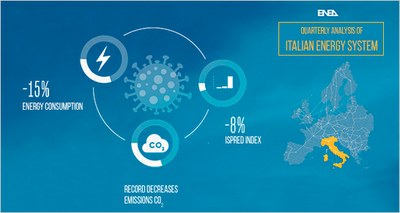Energy: COVID impact on consumption − March: -15% and record fall in CO2 emissions ISPRED Index -8%
7/5/2020
 The impact of COVID-19 on the national energy sector is reflected in consumption, prices and CO2 emissions data. These findings are reported in ENEA’s quarterly analysis of the Italian energy system, which highlights a 7% decrease vs 2019 in primary and final energy consumption [1] during the first three months of the year, with a peak of -15% for the month of March alone. In addition, ENEA estimates a possible 20% fall for the second quarter of 2020, markedly in excess of 10% for the entire half year, both in primary and final consumption terms.
The impact of COVID-19 on the national energy sector is reflected in consumption, prices and CO2 emissions data. These findings are reported in ENEA’s quarterly analysis of the Italian energy system, which highlights a 7% decrease vs 2019 in primary and final energy consumption [1] during the first three months of the year, with a peak of -15% for the month of March alone. In addition, ENEA estimates a possible 20% fall for the second quarter of 2020, markedly in excess of 10% for the entire half year, both in primary and final consumption terms.
During the first five weeks from the beginning of March on, electricity demand began to contract, stabilizing at -20% nationally (-30% in the Northern regions) compared to the same period of 2019. Natural gas consumption also stabilized at -30% as from the second half of March accompanied by a plunge in March for diesel and petrol (-43%).
Furthermore, during the first quarter of the year, CO2 emissions fell dramatically (approx. -10%), with -15% forecast for the half year. “An unprecedented drop”, concludes Francesco Gracceva, the ENEA expert who curated the Analysis, “considering that in 2019 there was a -1.5% drop, thanks to phasing out coal, favoured by low natural gas prices and the rise in the prices of emission allowances. In any case, despite the less positive economic trend, emission reductions in Italy over the last few years have been less marked than among the main European countries”.
As to prices, the ENEA Analysis shows that the sharp wholesale markets downturn of the first three months of the year, accentuated by the health crisis, has already produced significant effects for consumers. “During the first half of 2020, the price of electricity on the “mercato tutelato” (regulated market) will be 13% lower on average than during the second half of 2019, and that of gas 9% lower, compared to decreases for raw materials, of 26% for electricity and 12% for gas. These decreases”, the expert adds, “have not yet fully implemented the drops in wholesale prices, which in the half year may be around 30% for electricity, 20% for gas”.
The coronavirus emergency has overlapped with a declining consumption trend. Indeed, in 2019, after two years of slight increases, primary and final energy consumption fell by more than 1% mainly due to the drop in industrial production (-1.3% compared to 2018) and lower heating consumption, due to milder temperature conditions. The role of gas has grown in electricity production (+ 9%), which has become once more the main source of primary energy (36% of the mix). Fossil fuels remained stable at 75% [2] despite the sharp drop (-25%) in coal, while renewables saw an increase in wind power (+14%) and photovoltaic (+9%), while hydroelectric fell (-6%).
Given this scenario, transition of the energy system towards decarbonisation has come to a halt. The ISPRED Index, developed by ENEA to monitor this transition, recorded a drop in 2019 for the fourth year running (-8%), due to the substantially stationary situation as regards renewable sources and higher prices vs the previous year.
This issue of the Quarterly Analysis once more considers Italy’s competitiveness in the field of international trading of low-carbon energy technologies (photovoltaic, electric and hybrid vehicles, accumulators, solar thermal, wind). During the 2015-2019 period, Italy’s normalized balance pointed to a growing dependence on imports: at the close of 2019 the indicator stood at -0.53 (indeed, a rather high negative value). Particularly critical is the positioning for low-emission mobility (-0.97 for hybrid vehicles, -0.89 for electric vehicles), with a negative balance of 1.53 billion dollars (a value that also impacts the country’s trade balance).
The Analysis in full is available on the ENEA site, via this link: Analisi trimestrale ENEA
For further information:
Francesco Gracceva, ENEA – Responsabile Servizio Analisi del Sistema Energetico (director of energy system analysis service), francesco.gracceva@enea.it
[1] In terms of primary sources, the reduction in the first quarter was -3.5 Mtoe compared to the first three months of 2019, driven by oil and gas (approx. 1.5 Mtoe each, -12% oil, - 6% gas) with a drop in solids (e.g. coal) in excess of 0.5 Mtoe (according to preliminary estimates). On the other hand, renewable sources are expected to reach the same levels as the previous year, and imports of electricity are rising slightly (+0.2 Mtoe).
[2] In terms of primary sources, the reduction (approx. 2 Mtoe) in primary energy compared to 2018 may be ascribed to falls in the use of solids (-21%), of imported electricity (-13%) and of, to a lesser extent, oil (-0.8%), overall down by more than 3 Mtoe. Renewables increased (+1.3%), as did gas (+ 2.3%) especially (particularly in the thermoelectric sector).
